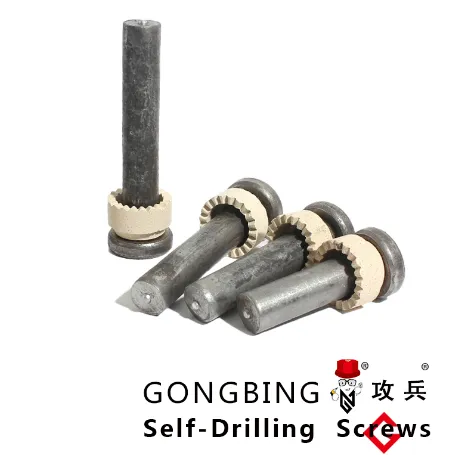The Unsung Hero of Steel Structures: The Heavy Hex Head Structural Bolt
In the vast and intricate world of construction, where towering skyscrapers and sturdy bridges defy gravity, lies a humble yet indispensable component—the Heavy Hex Head Structural Bolt. These robust fasteners play a pivotal role in ensuring the integrity and stability of steel structures, silently holding together the very fabric of our modern infrastructure. Today, we delve into the world of heavy hex head bolt and their significance in the realm of structural hex bolts, particularly the A325 variety, as well as their impact on black bolt applications in steel structures.

The Backbone of Steel Structures
Steel structures, be it skyscrapers, bridges, stadiums, or industrial facilities, are marvels of engineering that require meticulous planning and execution. At the heart of these structures lies a complex network of interconnected parts, held together by a myriad of fasteners. Among these, the Heavy Hex Head Structural Bolt stands out for its strength, versatility, and reliability.
With its distinctive hexagonal head designed for easy tightening and high torque transfer, the heavy hex head bolt is specifically engineered to withstand the rigorous demands of heavy-duty applications. Its large head area distributes the clamping force evenly across the joint, reducing the risk of material fatigue and failure.
Understanding the A325 Bolts
Within the realm of structural bolts, the A325 standard is a benchmark for quality and performance. A325 bolts for sale are premium-grade fasteners that meet or exceed strict industry standards, ensuring they are suitable for critical connections in steel structures. These bolts are typically made from high-strength alloy steel, heat-treated to achieve superior tensile strength and ductility.
The A325 designation signifies that these bolts are intended for use in structural steel joints where the bolts are tensioned to a specified preload during installation. This preload ensures that the joint remains tight and secure under load, effectively transferring forces between connected members.
The Role of Black Bolts in Steel Structures
When discussing black bolt in steel structure applications, it's essential to understand that the term "black" often refers to the finish of the bolt rather than its material composition. Black oxide coatings, commonly applied to steel bolts, provide a layer of corrosion resistance, enhancing the durability and longevity of the fasteners in harsh environments.
In steel structures, black bolts like A325 varieties are frequently employed due to their ability to withstand exposure to weather, chemicals, and other potential corrosive agents. The combination of their inherent strength, preload capabilities, and corrosion-resistant finish makes them an ideal choice for demanding applications where safety and reliability are paramount.
Installation and Maintenance
Proper installation of Heavy Hex Head Structural Bolt is crucial to ensure the structural integrity of the overall system. Tightening these bolts to the specified preload is essential to achieve the desired clamping force and prevent joint slippage. Torque control methods, such as the use of torque wrenches or hydraulic tensioners, are often employed to ensure accurate tightening.
Regular inspection and maintenance of these bolts are also vital. Over time, exposure to the elements, vibration, and cyclical loading can lead to degradation or loosening of the bolts. Regular inspections allow for the early detection and rectification of any issues, helping to prevent catastrophic failures.
Innovations and Future Trends
As technology advances, so do the materials and methods used in the manufacture of Heavy Hex Head Structural Bolt. New alloys and coatings are being developed to further enhance the strength, corrosion resistance, and sustainability of these fasteners. Additionally, advancements in installation techniques, such as automated tightening systems, are streamlining the process and improving efficiency.
Sustainability is also becoming a growing concern in the construction industry, leading to the development of bolts made from recycled materials and those with lower environmental impacts. As the world moves towards greener construction practices, structural hex bolts will continue to evolve, adapting to meet the demands of a changing landscape.
In conclusion, the Heavy Hex Head Structural Bolt is a testament to the ingenuity and precision of modern engineering. From its humble beginnings as a simple fastener, it has evolved into a vital component of steel structures, ensuring their safety, stability, and longevity. As we continue to build towards a brighter future, these bolts will remain an essential part of the construction landscape, silently holding up the skyscrapers and bridges that define our world.
-
Weatherproof Plastic Expansion Anchors for OutdoorNkhaniJun.06,2025
-
Sustainability in the Supply Chain: Eco-Friendly TEK Screws ProductionNkhaniJun.06,2025
-
Load-Bearing Capacity of External Insulation FixingsNkhaniJun.06,2025
-
Double Head Bolts: Enhancing Efficiency in Industrial MachineryNkhaniJun.06,2025
-
Corrosion Resistance in Chipboard Screws: Coatings for Wholesale DurabilityNkhaniJun.06,2025
-
Butterfly Toggle Bolts : Enhancing Structural ResilienceNkhaniJun.06,2025
